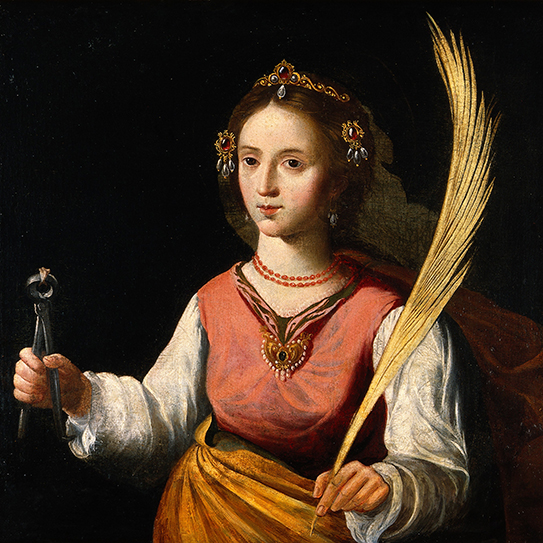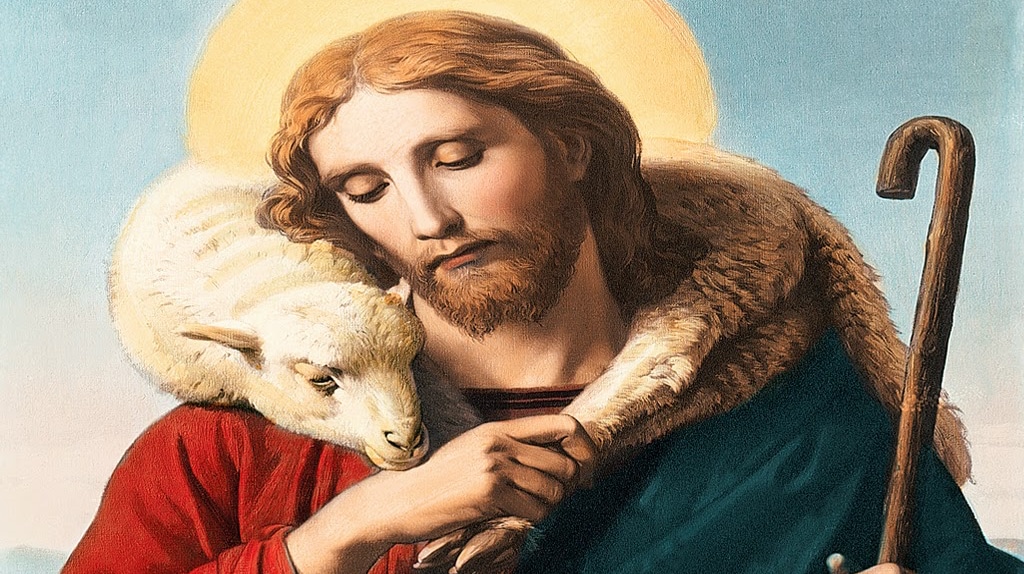St. Apollonia, Martyr, holding the tongs with which torturers pulled her teeth.
Dear Janet,
I knew nothing of Apollonia until this morning's (largely legendary) email account of her life arrived.
Not surprisingly, she is your patron saint, as she is of all who dread the dentist's chair.
Saint ApolloniaWikipedia
Saint Apollonia
Wikipedia
"St. Apollonia And A Hundred Medieval Holidays" Join Forces With "The Lost Art Of Catholic Drinking" To Prove That "A Cynic Is Someone Who Knows The Price Of Everything And The Value Of Nothing"
Last week, Danny and I had our throats blessed on St. Blaise's February 3rd feast day. https://en.wikipedia.org/wiki/Blessing_of_the_Throats (When you and I were young, was this ceremony "free-standing?"... or in conjunction with Mass?)
In the following biography of Blaise, notice that The Council of Oxford (1222) prohibited servile work on his feast day. http://www.americancatholic.org/Features/Saints/saint.aspx?id=1280
It is a little known fact -- strategically obscured by workaholic Protestant culture -- that the Catholic Church has always been a great lover of leisure and a liberator of the working class.
A superb account of Feast Days - which were once just that -- is online at https://www.sbg.ac.at/ges/people/rohr/nsk11.pdf
Excerpt: We may consider that the people living in the Middle Ages were free of labour on about 80 to 100 days a year. The amount of commemoration days, which were celebrated beside the 52 Sundays of a year, varied between 40 and about 60. Especially after the most important religious feasts, such as Christmas, Easter and Whitsunday, people did not work for a whole week. Work was forbidden on these days, including not only the work of the peasants and craftsmen, but also even female textile work at home. It was also prohibited to hold a fair or a judicial hearing, and also profane professions such as battles or travels were forbidden in many regions."
For a more popular view of medieval feasting, see http://rosaliegilbert.com/feastdays.html (Ironically, St. Apollonia is featured on this website!)
But back to Blaise...
Note his intimate relationship with wild animals - a commonplace occurrence in the lives of the saints. Blaise did not just "like" these creatures: he lived with them in their caves: the wolves, lions and bears were his community. (Here is a revealing page entitled “Saints and Animals” from the blog of the Southern African Faith Communities’ Environment Institute – http://safcei.blogspot.com/2008/06/saints-and-animals.html)
In the early days of Francis' brotherhood, "proto-Franciscans" living in caves and sleeping beneath rock outcroppings in the hills above Assisi (which I have had the pleasure to walk among), were such "feral" creatures that their wild aspect startled town-folk who came upon them unawares.
We Christians ought not be smarmy folk like those easily enamored of The Good Shepherd's popular images.
Images Of Yeshua, A Nazarene Carpenter
Yeshua invoked shepherds because of their disdained station in life. These itinerant pastors represented precisely the people Jesus saw predisposed to living The Way. Constant migration in search of "green pastures" made it impossible for shepherds to perform "the prescribed rites" at "the prescibed times," and so, "good church-going people" considered them non-observant sinners and social pariahs who deserved to be held in contempt.
As my pastor Tom Tully homilized one Sunday: "If Jesus came to Hillsborough, North Carolina this afternoon, he would not come to Holy Family Catholic Church. He would head immediately for 'the other side of the tracks.'"
"Who Were The Tax Collectors And Shepherds In Jesus' Time"http://paxonbothhouses.
"Shepherds," From Bruce Cockburn's Christmas Album
http://paxonbothhouses.blogspot.com/2013/12/shepherds-from-bruce-cockburns.html
Jesus: Festive Tippler And Friend Of Whores, Publicans, Tax Collectors And Sundry Sinners
http://paxonbothhouses.blogspo
The Lost Art Of Catholic Drinking
http://paxonbothhouses.blogspot.com/2015/08/the-lost-art-of-catholic-drinking.html
(In passing, I will note that The Woe Passages are insufficiently homilized - http://www.biblegateway.com/passage/?search=Matthew+23&version=NIV)
Love
Alan
PS I did not notice until re-reading Apollonia's "life" that the events of her story took place on the north coast of Egypt. Alexandria, as you know, was home to two of The Ancient World's wonders - the Light House, or Pharos, (whence the Spanish word Faro); and the world's greatest library, burned (accidentally?) by Caesar in 48 BC - after operating longer (with a continuously burning fire) than the United States has existed. http://en.wikipedia.org/wiki/Library_at_Alexandria
Recently, I saw a documentary which re-enacted the logistics of keeping the Pharos fire burning. An impressive undertaking! Rather like stoking the fires of Hell.
There was also the matter of getting all that fuel to the tower's top ... day after day, year after year, century after century.
The Lighthouse Of AlexandriaWikipedia
PPS I just posted my view of the crucial relationship between Religion and Culture which I metaphorize as the relationship between "doctrinal genotype" and "cultural phenotype."
Images Of Yeshua, A Nazarene Carpenter
Yeshua invoked shepherds because of their disdained station in life. These itinerant pastors represented precisely the people Jesus saw predisposed to living The Way. Constant migration in search of "green pastures" made it impossible for shepherds to perform "the prescribed rites" at "the prescibed times," and so, "good church-going people" considered them non-observant sinners and social pariahs who deserved to be held in contempt.
As my pastor Tom Tully homilized one Sunday: "If Jesus came to Hillsborough, North Carolina this afternoon, he would not come to Holy Family Catholic Church. He would head immediately for 'the other side of the tracks.'"
"Who Were The Tax Collectors And Shepherds In Jesus' Time"
http://paxonbothhouses.
"Shepherds," From Bruce Cockburn's Christmas Album
http://paxonbothhouses.blogspot.com/2013/12/shepherds-from-bruce-cockburns.html
Jesus: Festive Tippler And Friend Of Whores, Publicans, Tax Collectors And Sundry Sinners
http://paxonbothhouses.blogspo
The Lost Art Of Catholic Drinking
http://paxonbothhouses.blogspot.com/2015/08/the-lost-art-of-catholic-drinking.html
"Shepherds," From Bruce Cockburn's Christmas Album
http://paxonbothhouses.blogspot.com/2013/12/shepherds-from-bruce-cockburns.html
Jesus: Festive Tippler And Friend Of Whores, Publicans, Tax Collectors And Sundry Sinners
http://paxonbothhouses.blogspo
The Lost Art Of Catholic Drinking
http://paxonbothhouses.blogspot.com/2015/08/the-lost-art-of-catholic-drinking.html
Love
Recently, I saw a documentary which re-enacted the logistics of keeping the Pharos fire burning. An impressive undertaking! Rather like stoking the fires of Hell.
PPS I just posted my view of the crucial relationship between Religion and Culture which I metaphorize as the relationship between "doctrinal genotype" and "cultural phenotype."



No comments:
Post a Comment